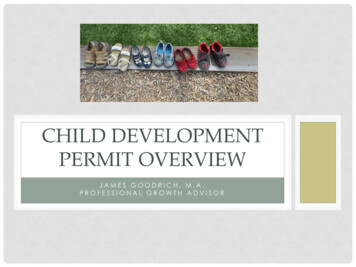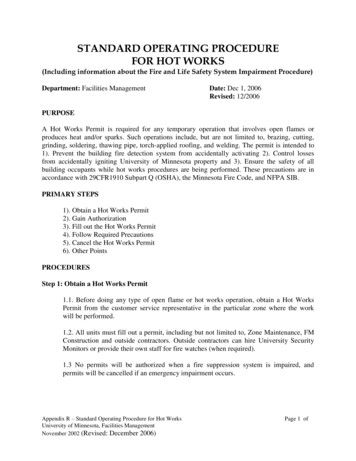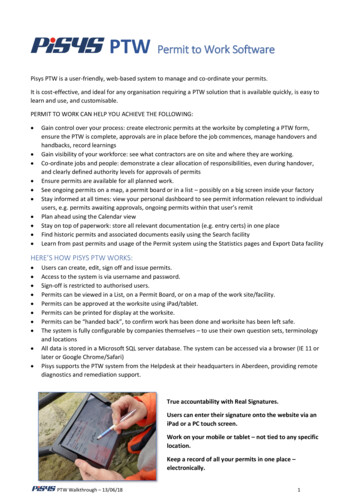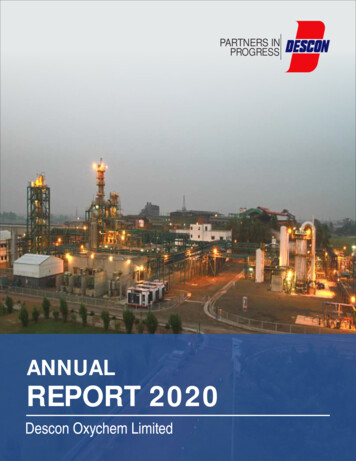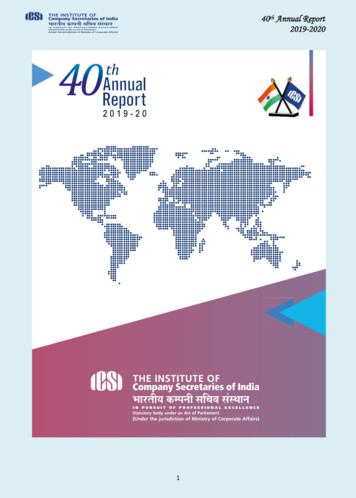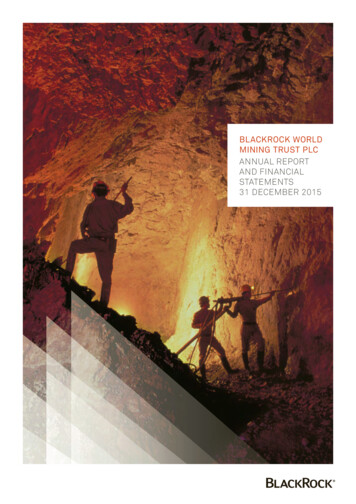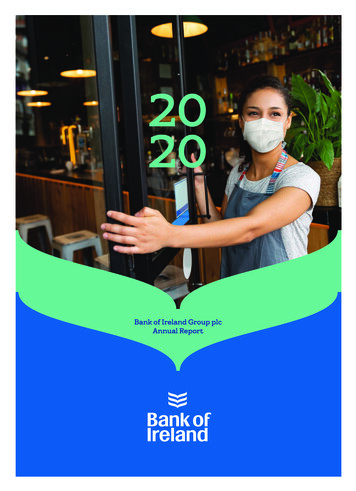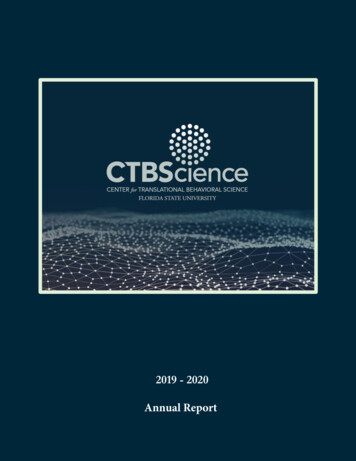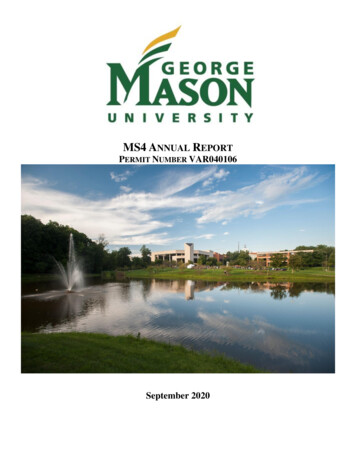
Transcription
MS4 ANNUAL REPORTPERMIT NUMBER VAR040106September 2020
GEORGE MASON UNIVERSITY MS4 ANNUAL REPORT, PERMIT NUMBER VAR040106PAGE LEFT INTENTIONALLY BLANK2019-2020
GEORGE MASON UNIVERSITY MS4 ANNUAL REPORT, PERMIT NUMBER VAR0401062019-2020Subject: GEORGE MASON UNIVERSITY MS4 ANNUAL REPORT, PERMIT NUMBER VAR040106Dated: September 26, 2020I certify under penalty of law that this document and all attachments were prepared under my direction orsupervision in accordance with a system designed to assure that qualified personnel properly gather and evaluatethe information submitted. Based on my inquiry of the person or persons who manage the system or those personsdirectly responsible for gathering the information, the information submitted is, to the best of my knowledge andbelief, true, accurate, and complete. I am aware that there are significant penalties for submitting falseinformation, including the possibility of fine and imprisonment for knowing violations.Sincerely,Frank Strike, P.E.Vice President of Facilities
GEORGE MASON UNIVERSITY MS4 ANNUAL REPORT, PERMIT NUMBER VAR040106PAGE LEFT INTENTIONALLY BLANK2019-2020
GEORGE MASON UNIVERSITY MS4 ANNUAL REPORT, PERMIT NUMBER VAR0401062019-2020Table of ContentsIntroduction and Background Information . 1Part I: Discharge Authorization and Special Conditions. 3SUMMARY (Part I D 2 a-2 e) . 3MS4 Program Plan. 3MCM#1: Public Education and Outreach . 3MCM#2: Public Involvement and Participation . 5MCM#3: Illicit Discharge Detection and Elimination . 7MCM#4: Construction Site Stormwater Runoff . 8MCM#5: Post-Construction Stormwater Management for New Development and Development on Prior DevelopedLands . 9MCM#6: Pollution Prevention /Good Housekeeping for Facilities Within the MS4 Area Owned and Operated by thePermittee . 11Part II: TMDL Special Conditions . 13AppendixAppendix A: Mason MS4 Boundaries and InterconnectivityAppendix B: Public Education and OutreachAppendix C: Public Involvement and ParticipationAppendix D: SWPPPAppendix E: Nutrient Management PlanAppendix F: Training Activities
GEORGE MASON UNIVERSITY MS4 ANNUAL REPORT, PERMIT NUMBER VAR040106PAGE LEFT INTENTIONALLY BLANK2019-2020
ABBREVIATIONS and ACRONYMSAbbreviation/AcronymBMPCWPDEQEHSESCFMMason LDMS4OoSSWMTMDLVESCL&RVESCPVPDESVSMPTermBest Management PracticeClean Water PartnersVirginia Department of Environmental QualityGeorge Mason University’s Environmental, Health, & SafetyErosion and Sediment ControlFacilities ManagementGeorge Mason University Facilities Land Development DivisionMunicipal Separate Storm Sewer SystemOffice of SustainabilityStormwater ManagementTotal Maximum Daily LoadVirginia Erosion and Sediment Control Law and RegulationsVirginia Erosion and Sediment Control PlanVirginia Pollutant Discharge Elimination SystemVirginia Stormwater Management Program
PAGE LEFT INTENTIONALLY BLANK
GEORGE MASON UNIVERSITY MS4 ANNUAL REPORT, PERMIT NUMBER VAR0401062019-2020Introduction and Background InformationStormwater discharges within George Mason University (Mason) are regulated under the terms of VPDESGeneral Permit for Discharges of Stormwater from Small Municipal Separate Storm Sewer System (MS4)(General Permit No. VAR040106). This MS4 permit is issued to Mason by Virginia DEQ, consistent with theprovisions of Section 402 of the Clean Water Act and the Virginia Stormwater Management Act, which authorizesthe Virginia Stormwater Management Program (VSMP) regulations.The MS4 permit was initially issued to Mason on July 9, 2008 for permit year 2008-2013. The second permit wasissued on July 2, 2013 for the permit year 2013-2018. On October 31, 2018, the MS4 permit was re-issued withan effective date of November 1, 2018 and an expiration date of October 31, 2023. Since the commencement ofthe effective permit coverage, Mason has begun implementing permit requirements and continues to work onimproving existing control measures developed to reduce the discharges of pollutants into Mason’s storm sewersystem.Mason’s MS4 Permit covers two separate Northern Virginia campuses in Fairfax and Prince William County(Appendix A). Both are located in the Potomac watershed within the larger Chesapeake Bay watershed.Fairfax Campus consists of approximately 585 acres of developed and undeveloped land comprised of academicbuildings, research facilities, residential buildings, auxiliary buildings, and athletic facilities. Approximately 220acres drains to Popes Head Creek. The remaining 365 acres drains to Pohick Creek. Fairfax Campus is physicallyinterconnected to these MS4’s: Fairfax County, City of Fairfax, and the Virginia Department of Transportation(VDOT) (Appendix A). The stormwater system at Fairfax Campus encompasses roughly 680 storm inlets and16 miles of storm sewer pipes.Science and Technology Campus is located in Prince William County and consists of approximately 135 acres ofdeveloped and undeveloped land that includes academic buildings, research facilities, auxiliary buildings, andathletic facilities. All 135 acres are within the Broad Run drainage area. Science and Technology campus isphysically interconnected to other MS4s including Prince William County and VDOT. The stormwater runofffrom the Science and Technology Campus is captured by roughly 50 storm inlets and transported through 2 milesof storm sewer pipes into a tributary to Cannon Branch.Currently, over 37,000 students attend Mason with approximately 6,000 living on the Fairfax campus. Thenumber of students living on campus has been reduced to approximately 4,500 due to the pandemic. Masonanticipates continuous growth in enrollment in the future.While stormwater activities and functions are divided among several different departments and divisions, theMason Land Development (Mason LD) has the primary responsibility for overall compliance with the permitrequirements. MS4 permit compliance activities are coordinated with Environmental Health and Safety Office(EHS), Facility Management (FM), and other Mason units. While Mason LD is the responsible foroverall program compliance, including annual report submittal, several other departments and divisions playimportant roles in implementing the MS4 permit requirements. These departments are shown in the followingorganization chart.1
GEORGE MASON UNIVERSITY MS4 ANNUAL REPORT, PERMIT NUMBER VAR0401062019-20202
GEORGE MASON UNIVERSITY MS4 ANNUAL REPORT, PERMIT NUMBER VAR0401062019-2020Part I: Discharge Authorization and Special ConditionsSUMMARY (Part I D 2 a-2 e)Mason LD prepared this annual report for General VPDES Permit for Discharges of Stormwater From SmallMunicipal Separate Storm Sewer Systems (MS4) (General Permit No. VAR040106). The Permit has the effectivedate of November 1, 2018 and the expiration date of October 31, 2023. This report covers the reporting period ofJuly 1, 2019 through June 30, 2020.Mason’s MS4 Program applies to all activities undertaken by Mason, either by its internal workforce or contractedto external entities, where such activities are regulated by VSMP Permit Regulations. Compliance with thepermitted MS4 Program (and all parts thereof) will be verified during inspections of Mason’s land disturbingactivities, whether internally or by DEQ, Environmental Protection Agency (EPA), or other applicableenvironmental agencies.This MS4 permit covers the Fairfax campus and Science and Technology Campus (previously Prince Williamcampus). Mason oversees Arlington Campus on an administrative basis. Other remote locations are includedunder the MS4 permits of their respective local jurisdictions.Mason’s MS4 Report is submitted to the DEQ for review and approval on an annual basis. Mason will ensurecompliance with the General VPDES Permit for MS4s effective on November 1, 2018. This submittal constitutesMason’s commitment to execute all provisions contained herein on regulated land disturbing activities, landdevelopment projects, and operation and maintenance of installed stormwater management facilities. As such,this report will be made available to Mason and DEQ personnel and is available for download as a PDF file at:https://stormwater.gmu.edu.Detailed status updates on compliance with each reporting items on Minimum Control Measures (MCMs) in PartI E are listed below. Mason remains compliant with the permit requirements.MS4 Program PlanMason evaluated and updated the MS4 Program Plan in April 2019 to meet the current permit requirements. Theplan establishes and defines Mason’s MS4 program, and demonstrates Mason’s plan to meet the permitrequirements through October 31, 2023. The program plan is a living document and will be updated, through thepermit cycle where necessary. The most up-to-date MS4 Program Plan is available on the websitehttps://stormwater.gmu.eduMCM#1: Public Education and OutreachThe Public Education and Outreach Program at Mason seeks to alert students, faculty and staff on the impacts ofstormwater runoff on water quality through various communication channels. It provides guidance on how thecommunity can help in minimizing adverse impacts of urban runoff in waterways.Mason utilizes existing programs, organizations, boards, and committees within the community to implementpublic education activities. The Public Education and Outreach program at Mason uses existing forums andoutreach materials established by EPA and Northern Virginia Clean Water Partners (CWP). In addition, Mason3
GEORGE MASON UNIVERSITY MS4 ANNUAL REPORT, PERMIT NUMBER VAR0401062019-2020staff develops educational brochures and materials to send specific messages to Mason students, faculty and staff.Samples of brochures and outreach materials developed by Mason LD can be found in Appendix B. Thesematerials are widely distributed by Mason staff members at various events and meetings. As a member of CWP,Mason also participates in the CWP education campaign, which uses multi-media approach to educate the publicon stormwater pollutions. Cable televisions, ads, promotional items, the Only Rain website (www.onlyrain.org),print materials, and internet banner ads are used to reach a large audience around the regions.Part I E 1 g (1): A list of the high-priority stormwater issues the permittee addressed in the public education andoutreach programMason and CWP have identified the high priority regional water quality issues that contribute the pollution ofstormwater runoff at Mason: bacteria, nutrients, and motor oil/chemical contaminants. These high priority waterquality issues are listed below along with the rationale for their selection.High Priority IssuesBacteriaSelection RationaleBacteria pollution in stormwater runoff come from leaking sanitary sewer pipes,wildlife (i.e. Canada geese), and improper disposal of pet waste. Due to the significantnumber of geese population and pet owners in the community, Mason choosesstudents, faculty, staff members and campus visitors as the target audience and theeducation and outreach messages focused on proper disposal of pet waste.NutrientNitrogen and phosphorus are two of the three pollutants listed in Mason’s MS4 Permitrequiring an action plan for the Chesapeake Bay TMDL. Over fertilization of lawnsprovides a direct runoff source of nitrogen and phosphorous to streams. Withapproximately 134 acres of turf areas in the Mason and over 5,000 residentialstudents/faculty on campus, the public awareness of the effects on over-fertilization isimportant to reducing those pollutants in stormwater.Motor Oil/Chemical Oils that leaks from cars onto roads and parking lots was washed into storm drains andContaminantsthen flow directly to a pond or stream. With 4 million square feet of parking lots andover 20,000 active parking permits, Mason chooses to target students, faculty and staffmembers with educational messages focused on prevention of fuel spills, illicitdischarges, and improper handling of motor oils, anti-freeze and other hazardouswaste.Part I E 1 g (2): A list of strategies used to communicate each high-priority issuesIn this reporting period, Mason LD implemented the following strategies on campuses to explain to Masonstudents, faculty and staff members the importance of the high-priority stormwater issues identified above.Through these strategies, Mason LD informed Mason students, faculty, and staff members the actions they cantake to minimize the impact of the high-priority stormwater issues.StrategiesTraditional writtenmaterialsAlternative materialsImplementation at MasonMason LD developed and distributed informational brochures, posters, bookmarks,etc. on various outreach events to increase public’s knowledge on stormwaterpollution.Mason LD distributed dog waste bags, hand sanitizers, pens, etc. to increasepublic’s knowledge on stormwater pollution.4
GEORGE MASON UNIVERSITY MS4 ANNUAL REPORT, PERMIT NUMBER VAR040106StrategiesSpeaking Engagements2019-2020Implementation at MasonMason LD presented at Civil Engineering classes to teach Mason students theimportance on high-priority water quality issues and reducing waste on campus.Mason LD presented at annual Virginia Water Conference on Mason’s strategy toengage students, faculty and staff members.MCM#2: Public Involvement and ParticipationMason encourages residents and students to participate in volunteer programs hosted on campus for conservationand improvement of water resources. Projects such as Campus Stream Cleanups are conducted every year withthe purpose of getting the community involved in the Mason’s efforts on reducing the amount of pollutant loadsin stormwater. Educational workshops and materials, offered by Mason, also provide information to the publicabout stormwater management practices implemented on campus and different sustainable practices that can helprestore and protect surface waters.Mason LD has developed a website dedicated to water quality and stormwater managementhttps://stormwater.gmu.edu/. The site provides information on Mason’s MS4 program, serves as a forum todistribute educational materials, and includes information on where to report potential illicit discharges. Itprovides water quality and pollution prevention information to the general public in an easily accessible format.It also provides public access to documents such as Mason’s MS4 program plan, annual reports, and TMDL actionplan.Part I E 2 f (1): A summary of any public input on the MS4 program received (including stormwater complaints)and how the permittee respondedIn this reporting period, Mason has received zero public comments in regards of Mason’s MS4 program.Part I E 2 f (2): A website address to the permittee’s MS4 program and stormwater websiteMason LD has developed a website dedicated to water quality and stormwater managementhttps://stormwater.gmu.edu/. The site provides public access to documents such as Mason’s MS4 Permit, the MS4program plan, annual reports, and TMDL action plan. It provides a mechanism for the public to report potentialillicit discharge, improper disposal, spills to MS4, complaints regarding the land disturbing activities and/or otherpotential stormwater pollution concerns. Contact information is available online for the public to provide inputson the MS4 program.In this reporting period, Mason implemented an online reporting tool, which made it easier for the public to submitany comments and feedback to Mason LD. It is available at https://stormwater.gmu.edu/Part I E 2 f (3): A description of the public involvement activities implemented by the permitteeDue to the COVID-19 outbreak, Mason switched to online learning between March 13 and August 24, 2020.Several planned outreach events had been cancelled or postponed. Despite the unexpected challenges, Mason LDwas able to fulfill the permit requirements for this reporting period.5
GEORGE MASON UNIVERSITY MS4 ANNUAL REPORT, PERMIT NUMBER VAR0401062019-2020In this reporting period, Mason led one cleanup event, hosted educational booth at several events, and presentedto students at several classrooms. In addition, Mason participated and presented at the annual Virginia WaterConference. These events provided hands-on opportunities for Mason students, staff, faculty members, andcommunity visitors to learn about high priority stormwater issues and ways to protect the streams and theenvironment. Mason LD received positive feedbacks from the participants. The details about each activity withevaluation metrics are shown below and Appendix ionEducationalEventsInformation partmentInformation FairEducationalEventsVirginia vents*Campus Cleanup*Eco ivity detailsA group of student volunteers cleaned up the Piedmont-Tidewaterraingarden as part of Mason Nation 9/11 Day of Service onSeptember 11, 2019. Duties included pick up and sort trash, removeweeds, and replenish mulch.On November 14, 2019, Mason LD presented Mason MS4 program,internship and Patriot Green Fund projects to students at class CEIE340 Water Resources Engineering.On December 2, 2019, Mason LD staff handed out Mason LDbrochures with facts about stormwater and information on futureevents to students, faculty, and staff on campus.On Feb 8, 2020, Mason LD presented Mason MS4 program,internship and Patriot Green Fund projects to students at class EVPP442 Ecosystem and Processes. Mason LD staff also led a field visitto rain gardens and stream restoration project.On February 14, 2020, Mason LD staff presented Mason MS4program, internship and Patriot Green Fund projects to students atclass CEIE 355 Environmental Engineering and Science class.As part of Mason staff appreciation day on February 27, 2020, staffand non-students wage employees had the opportunity to learnabout Mason LD office functions on MS4 program, BMPs oncampus and upcoming events.On March 9-10, 2020, Mason LD presented in Virginia WaterConference with more than 400 participants from floodplain andstormwater management professional community. Presentationdiscussed Mason’s strategy to maximize campus resources toadvance the stormwater program, including Mason LD sponsoredcapstone project to design and build a custom-made robot to inspectMason’s storm drains.Fairfax Campus Cleanup was planned for April 15, 2020.Mason LD planned to host a booth on Mason EcoFest on April 22,2020 Earth Day to distribute information on stormwatermanagement to students and community visitors.A group of student plans to improve 2 trash cans enclosures bases atMasonvale housing community. The purpose of the event is toimprove the drainage area to a permeable pavement facility anddistribute information on BMPs and stormwater. This event wasplanned for 2020 Earth month.6
GEORGE MASON UNIVERSITY MS4 ANNUAL REPORT, PERMIT NUMBER VAR0401062019-2020CategoryActivitiesActivity detailsPollutionStorm DrainMason LD marked 40 storm drains in Science and TechnologyPreventionMarking Eventcampus.*All campus events were cancelled between March 13 and August 24, 20202 due to COVID-19 outbreak.Part I E 2 f (4): A report of metric as defined for each activity and an evaluating as to whether or not the activityis beneficial to improving water qualityFor each public involvement activity, Mason keeps track of participant engagement through numbers ofparticipants, numbers of brochures and/or promotional items handed out, numbers of contact informationcollected, and/or weights of trash/recyclable materials collected. The metrics for the public involvement eventsin this reporting period are shown in the table above. Mason LD continues to receive positive feedbacks fromparticipants at these activities and will continue to investigate additional opportunities to increase publicparticipation.Part I E 2 f (5): The name of other MS4 permittees with whom the permittee collaborated win the publicinvolvement opportunitiesMason LD did not collaborate with other MS4 permittees on the activities shown above. Mason received supportfrom Alice Ferguson Foundation and CWP who provided trash bags, gloves, and dog waste bags for the streamcleanup events.MCM#3: Illicit Discharge Detection and EliminationIn order to detect and eliminate both direct and indirect illicit discharges, Mason has established Illicit DischargeDetection and Elimination Program (IDDE), which relies on Mason’s Illicit Discharge Detection and EliminationPolicy to prohibit any non-stormwater discharges into the sewer system or any receiving waterway. The policy isenforced by both Mason LD and EHS, who rely strongly on regular inspections and public notification. Masonencourages the community’s contribution in discovering and reporting possible polluted runoff and maintainsappropriate staffing to address such reported concerns. Instructions on how to report concerns or potential illicitdischarges are available online at the Mason LD website.Mason LD maintains stormwater system maps and publishes interactive stormwater maps using online GIS. Themaps can be found on Mason LD website. The complete MS4 maps with outfall information table are availableupon request.Mason LD performs dry weather screening (outfall reconnaissance) twice a year on the outfalls to identifypossible illicit connections and discharges, as well as, to keep track of all existing stormwater managementfacilities and structures within the MS4 boundary. During the outfall reconnaissance, outfalls are evaluated forstructural damages or uncommon conditions that might indicate the present of pollutants. In addition, outfalls areinspected for possible maintenance necessity to avoid detrimental conditions on stream banks and bed.Mason has interconnections with the stormwater system operated by Fairfax County, Fairfax City, PrinceWilliam County and VODT.7
GEORGE MASON UNIVERSITY MS4 ANNUAL REPORT, PERMIT NUMBER VAR0401062019-2020Part I E 3 e (1): A confirmation statement that MS4 map and information table have been updated to reflect anychanges to the MS4 occurring on or before June 30 of the reporting year.Mason’s stormwater system maps and information table have been updated to reflect the current site conditionincluding any changes to the MS4 occurring on or before June 30 of this reporting year. The maps including theinformation tables were submitted to DEQ on March 25, 2020.Part I E 3 e (2): The total number of outfalls screened during the reporting period as part of the dry weatherscreening programA total of number of 69 outfalls were screened during this reporting year as part of the dry weather screeningprogram (outfall reconnaissance) and no illicit discharges were identified during the outfall reconnaissance.Part I E 3 e (3): A list of illicit discharges to the MS4 including spills reaching the MS4 with information asfollows: (a) the source of illicit discharge; (b) the dates that the discharge was observed, reported or both; (c)whether the discharge was discovered by the permittee during dry weather screening, reported by the public orother methods (describe); (d) how the investigation was resolved; (e) a description of any follow-up activities;and (f) the date the investigation was closed.Mason received five reports for potential illicit discharge incidents from the public and Mason staff. Afterinvestigations conducted by EHS, it was determined that three of them were illicit discharges within or reachingMason’s MS4 boundary. Proper actions had been taken to remove and mitigate the illicit discharges.MCM#4: Construction Site Stormwater RunoffMason has developed Annual Standards and Specifications for Erosion and Sediment Control and StormwaterManagement (AS&S) in accordance with Virginia Erosion and Sediment Control law and regulations, andVirginia Stormwater Management Act and program. It is an integral component of all design, construction,maintenance, and management of Mason’s facilities and campuses. It is enforced during the planning, permitting,and construction phases by Mason LD staff. Mason personnel receive training by DEQ on ESC and SWM, inorder to enforce such programs. Certified staff is responsible for reviewing plans during the permitting processand conducting regular inspections on project sites during construction. Plan review and inspection proceduresare implemented in accordance with state laws and regulations and Mason’s AS&S. A copy of Mason’s AS&S isavailable at Mason LD website and/or provided upon request.Part I E 4 d (1): If the permittee implements a construction site stormwater runoff program in accordance withPart 1 E 4 a (3)(a) A confirmation statement that land disturbing projects that occurred during the reporting period havebeen conducted in accordance with the current department approved standards and specifications forerosions and sediment control(b) If one or more of the land disturbing projects were not conducted with the department approvedstandards and specifications, an explanation as to why the projects did not conform to the approvedstandards and specificationsAll land disturbing projects that occurred during the reporting period have been conducted in accordance withDEQ approved Annual Standards and Specifications for Erosion and Sediment Control and Stormwater8
GEORGE MASON UNIVERSITY MS4 ANNUAL REPORT, PERMIT NUMBER VAR0401062019-2020Management.Mason strives to provide a bright and innovative environment for our growing campus community. As a result,the campuses continue to experience new construction and/or renovation projects. During the reporting period,Mason has five active construction projects in Fairfax Campus and Science and Technology Campus (PrinceWilliam County). Locations of current and future projects are also available on Mason Facilities websiteFor all active construction projects listed below, Mason LD staff perform regular inspections to ensure that erosionand sediment controls were properly implemented and maintained during the construction. Issues and violationsobserved during inspection were photographed and documented in the inspection reports. In addition, requiredcorrective actions for each issue or violation were specified and with a date by which all corrective actions mustbe completed. Critical areas that require continuous inspections would be identified on the site plan, if necessary.The inspection reports were sent to the Contractor, Project Managers, Mason LD and other responsible partieswith 24 hours of inspection and follow-up inspections will be performed when necessary.Construction ProjectProject ScheduleHylton Performing Arts AdditionRobinson Hall ReplacementUtilities Distribution SystemFairfax Water TowerShenandoahParkingBankStabilizationAug 2018 to Dec 2019Aug 2018 to Jan 2022Aug 2018 to Aug 2021Dec 2018 to May 2020Jan 2020 to Jan 2020Number of Inspections Enforcementin the reporting periodactions31044048033020Part I E 4 d (2): Total number of inspections conductedTotal number of inspections conducted by Mason LD staff in the reporting period are shown in the table above.Part I E 4 d (3): Total number and type of enforcement actions implemented and the type of enforcement actionsIn the reporting period, Mason didn’t issue any enforcement actions, such as stop-to-work order. Howevernumerical corrective actions were conveyed to contractors and project managers through inspection reports toensure the compliance with the approved AS&S.MCM#5: Post-Construction Stormwater Management for New Development and Development onPrior Developed LandsAs a non-traditional small MS4, Mason has direct control over planning, design, construction and postconstruction of stormwater management facilities, also called best management practices (BMPs.) The MS4program at Mason consists of minimizing the impacts of runoff associated with land disturbance such as flooding,erosion, and water pollution. Current practices implemented by Mason in managing and controlling stormwaterfocus on promoting natural hydrologic processes as well as minimizing contact of pollutants with rainwater. Asland disturbing activities take place, Mason incorporates measures that protect and/or improve natural areasduring and after construction. In addition to the ongoing efforts to preserve the natural landscape, Mason strivesto reduce impervious areas as much as possible and create more vegetated regions.9
GEORGE MASON UNIVERSITY MS4 ANN
https://stormwater.gmu.edu MCM#1: Public Education and Outreach The Public Education and Outreach Program at Mason seeks to alert students, faculty and staff on the impacts of stormwater runoff on water quality through various communica
